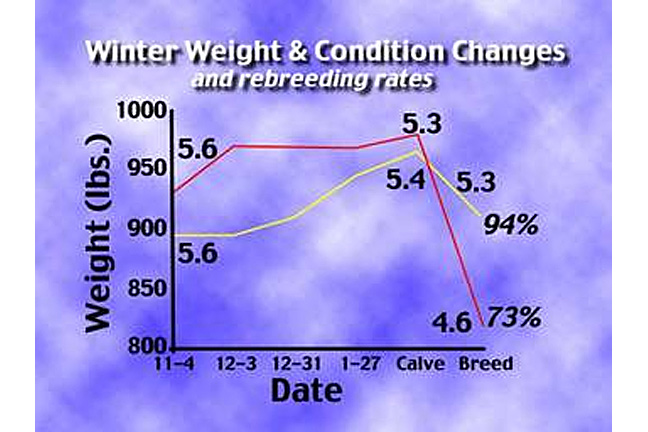
Agricultural News
Glenn Selk Looks at the Importance of Energy Intake in Post-Calving Cows
Wed, 26 Mar 2014 16:56:05 CDT

Change in body condition after calving influences rebreeding rates. Cows that maintain body condition (yellow line) had a rebreeding rate of 94%. Cows that lost body condition after calving (red line) had a rebreeding rate of 73% (Wettemann, et al., 1987 Journ. Animal Sci., Suppl. 1:63).
Glenn Selk, Oklahoma State University Emeritus Extension Animal Scientist, writes in the lates Cow-Calf newsletter:
The winter of 2013-2014 has brought challenges in the form of very high feed prices, cold weather, and in some instances, short hay supplies. Cows in many Midwestern herds are calving in marginal body condition. Unfortunately, this is a season where maintaining or gaining body condition on spring calving cows is really quite difficult. Warm season grasses have not yet begun to grow. Dormant grass (what little is left) is a low quality feed. Cows cannot, or will not, consume a large amount of standing dormant grass at this time year. If the only supplement being fed is a self-fed, self-limited protein source, the cows may become very deficient in energy. Remember, the instructions that accompany these self-fed supplements. They are to be fed along with free choice access to adequate quantity and quality forages.
There is another factor that compounds the problem. A small amount of winter annual grasses may begin to grow in native pastures. These are the first tastes of green grass many cows have seen since last summer. The cows may try to forage these high moisture, low energy density grasses, in lieu of more energy dense hays or cubes. The sad result is the loss of body condition in early lactation beef cows just before the breeding season is about to begin.
Body condition at the time of calving is the most important factor affecting rebreeding performance of normally-managed beef cows. Nonetheless, condition changes after calving will have more subtle effects on rebreeding especially in cows that are in marginal body condition. Body condition changes from the time the cow calves until she begins the breeding season can play a significant role in the rebreeding success story. This appears to be most important to those cows that calve in the marginal body condition score range of "4" or "5". An Oklahoma trial illustrates the vulnerability of cows that calve in the body condition score of 5. Two groups of cows began the winter feeding period in similar body condition and calved in very similar body condition. However, after calving and before the breeding season began, one group was allowed to lose almost one condition score. The other group of cows was fed adequately to maintain the body condition that they had prior to calving. The difference in rebreeding rate was dramatic (73% vs 94%). Again this illustrates that cows that calve in the body condition score of 5 are very vulnerable to weather and suckling intensity stresses and ranchers must use good nutritional strategies after calving to avoid disastrous rebreeding performance.
Hereford and Angus cows in the 1980's were much smaller than most cows today but the body condition score is still the same. Cows should calve in moderate to good condition (scores of 5 or 6) to ensure good rebreeding efficiency. Ideally, cows should be maintaining condition during mid to late pregnancy and gaining during breeding. The goal of the management program should be to achieve these body conditions by making maximum use of the available forage resource.
Continue feeding a source of energy, such as moderate to good quality grass hay free choice and high energy supplements until the warm season grasses grow enough to provide both the energy and protein that the lactating cows need. Yes, the feed is high-priced. But the cost of losing 21% of next year's calf crop is even greater!
WebReadyTM Powered by WireReady® NSI
Top Agricultural News
More Headlines...




















